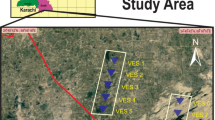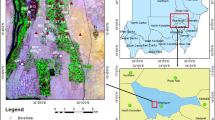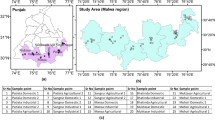Abstract
Climate-induced water scarcity is a growing problem in semi-arid regions like Peshawar basin, Pakistan. The present study integrates geophysical, pumping test, and physicochemical and geospatial datasets to categorize the stressed aquifer in Peshawar Basin, a part of “One Belt one road system”. Previous studies in the area have solely focused on water quality deterioration using geochemical tools only. The present study integrates multiple tools to assess the interaction of the surface and subsurface water. Furthermore, the study provides a controlled tool prediction mechanism for aquifer transmissivity instead of cost-effective pumping test. The results are achieved by utilizing 13 Vertical Electrical Sounding (VES) points, pumping data of 16 wells, and physiochemical data of 108 surface and groundwater samples. The spatio-temporal variations of hydraulic properties using inverse distance weightage tool (IDW) played a role for zonation. An unconfined quaternary alluvial aquifer was identified with thickness ranging 6.32–341 m comprising of gravels whose thickness is decreasing towards the eastern part in the study area. The high values of longitudinal conductance and weak-to-moderate protective capacity marks the vulnerable aquifer in Maini, Kotha and Gadoon Amazai Industrial Estate. The data also revealed increased clay content in eastern part of study area resulting in decreased Transmissivity and Specific Capacity. Increased Total Dissolved Solvents (TDS) in post-monsoon water samples is contributed by high clay content. The spatio-temporal variations of parameters helped in differentiation of the anthropogenic and geogenic sources of contamination. The physiochemical and microbial analysis concluded that water of the area is not suitable for drinking, as results are exceeding the WHO guidelines. The results can be judiciously used in planning and development of the groundwater resources in Quaternary basins of the world.









Similar content being viewed by others
Data availability
The data is available with the first author Mrs. Sidra Daud and can be provided upon request.
References
Adabanija MA, Ajibade RA (2020) Investigating groundwater corrosion and overburden protective capacity in a low latitude crystalline basement complex of southwestern Nigeria. NRIAG J Astron Geophys 9(1):245–259
Ahmad N, Khan S, Ehsan M, Rehman FU, Al-Shuhail A (2022) Estimating the total volume of running water bodies using geographic information system (GIS): a case study of Peshawar Basin (Pakistan). Sustainability 14(7):3754
Ajiboye Y, Isinkaye MO, Badmus GO, Faloye OT, Atoiki V (2022) Pilot groundwater radon mapping and the assessment of health risk from heavy metals in drinking water of southwest Nigeria. Heliyon 8(2):e08840
Akhtar N, Syakir Ishak MI, Bhawani SA, Umar K (2021) Various natural and anthropogenic factors responsible for water quality degradation: a review. Water 13(19):2660
Ali W, Muhammad S (2022) Spatial distribution of contaminants and water quality assessment using an indexical approach, Astore River basin, Western Himalayas Northern Pakistan. Geocarto Int 37:1–22
Ali S, Nawaz T (2020) Galvanizing development in Khyber Pakhtunkhwa through China Pakistan economic corridor projects. Routledge, London
Ali N, Kalsoom Khan S, Ihsanullah Rahman IU, Muhammad S (2018) Human health risk assessment through consumption of organophosphate pesticide-contaminated water of Peshawar basin, Pakistan. Expo Health 10:259–272
Ali Y, Pervez H, Khan J (2020) Selection of the most feasible wastewater treatment technology in Pakistan using multi-criteria decision-making (MCDM). Water Conserv Sci Eng 5:199–213
Amin N, Ayaz M, Alam S, Gul S (2014) Heavy metals contamination through industrial effluent to irrigation water in Gadoon Amazai (Swabi) and Hayatabad (Peshawar) Pakistan. J Sci Res 6(1)
Anabaraonye B, Evelyn ORJI, Beatrice EWA, Arinze C (2023). Green Entrepreneurial Opportunities in Wastewater Management: Implications for Sustainable Economic Growth in Nigeria: Green Entrepreneurial Opportunities in Wastewater Management: Implications for Sustainable Economic Growth in Nigeria. Covenant Journal of Entrepreneurship, 6–6
Ashraf S, Ali Q, Zahir ZA, Ashraf S, Asghar HN (2019) Phytoremediation: Environmentally sustainable way for reclamation of heavy metal polluted soils. Ecotoxicol Environ Safety 174:714–727
Attwa M, Basokur AT, Akca I (2014) Hydraulic conductivity estimation using direct current (DC) sounding data: a case study in East Nile Delta, Egypt. Hydrogeol J 22(5):1163–1178
Bibi M, Wagreich M, Iqbal S, Gier S, Jan IU (2020) Sedimentation and glaciations during the Pleistocene: palaeoclimate reconstruction in the Peshawar Basin Pakistan. Geol J 55(1):671–693
Binley A, Hubbard SS, Huisman JA, Revil A, Robinson DA, Singha K, Slater LD (2015) The emergence of hydrogeophysics for improved understanding of subsurface processes over multiple scales. Water Resour Res 51(6):3837–3866
Bohling GC, Butler JJ Jr, Zhan X, Knoll MD (2007) A field assessment of the value of steady shape hydraulic tomography for characterization of aquifer heterogeneities. Water Resour Res. https://doi.org/10.1029/2006WR004932
Daud S, Nisar UB (2022) Integrated geophysical, geochemical, and geospatial tools to characterize water resources in GAIE, Eastern Peshawar basin Pakistan. Environ Earth Sci 81(15):390
Efremenko E, Aslanli A, Lyagin I (2023) Advanced situation with recombinant toxins: diversity, production and application purposes. Int J Mol Sci 24(5):4630
Ekanem AM, Akpan AE, George NJ, Thomas JE (2021) Appraisal of protectivity and corrosivity of surficial hydrogeological units via geo-sounding measurements. Environ Monit Assess 193:718
Falowo OO (2023) Modeling of hydrogeological parameters and aquifer vulnerability assessment for groundwater resource potentiality prediction at Ita Ogbolu, Southwestern Nigeria. Model Earth Syst Environ 9(1):749–769
Farid A, Jadoon K, Akhter G, Iqbal MA (2013) Hydrostratigraphy and hydrogeology of the western part of Maira area, Khyber Pakhtunkhwa, Pakistan: a case study by using electrical resistivity. Environ Monit Assess 185:2407–2422
Forster B, Pinedo CA (2015) Bacteriological examination of waters: membrane filtration protocol. American Society for Microbiology. https://www.asmscience.org/content/education/protocol/protocol.3982# Accessed: 19 Jan 2021
González JAM, Comte JC, Legchenko A, Ofterdinger U, Healy D (2021) Quantification of groundwater storage heterogeneity in weathered/fractured basement rock aquifers using electrical resistivity tomography: sensitivity and uncertainty associated with petrophysical modelling. J Hydrol 593:125637
Haripriya PR, Shaju N, Soman S, Siddharth Y, Levan KV (2014) Evaluation of aquifer parameters from drawdown and pumping out data in open wells. Doctoral dissertation, Department of Irrigation and Drainage Engineering
Hussain E, Rao MF (2020) China–Pakistan economic cooperation: the case of special economic zones (SEZs). Fudan J Hum Soc Sci 13:453–472
Hussain A, Yeats RS (2009) Geological setting of the 8 October 2005 Kashmir earthquake. J Seismolog 13:315–325
Hussain Y, Ullah SF, Hussain MB, Aslam AQ, Akhter G, Martinez-Carvajal H, Cárdenas-Soto M (2017) Modelling the vulnerability of groundwater to contamination in an unconfined alluvial aquifer in Pakistan. Environ Earth Sci 76:1–11
Hussain A, Ali I, Kaleem WA, Yasmeen F (2019) Correlation between body mass index and lipid profile in patients with type 2 diabetes attending a tertiary care hospital in Peshawar Pakistan. J Med Sci 35(3):591
Hussain R, Khattak SA, Ali L, Sattar S, Zeb M, Hussain ML (2021) Impacts of the linear flowing industrial wastewater on the groundwater quality and human health in Swabi Pakistan. Environ Sci Pollut Res 28(40):56741–56757
Kazakis N, Pavlou A, Vargemezis G, Voudouris KS, Soulios G, Pliakas F, Tsokas G (2016) Seawater intrusion mapping using electrical resistivity tomography and hydrochemical data. An application in the coastal area of eastern Thermaikos Gulf Greece. Sci Total Environ 543:373–387
Khan A, Khan S, Khan MA, Qamar Z, Waqas M (2015) The uptake and bioaccumulation of heavy metals by food plants, their effects on plants nutrients, and associated health risk: a review. Environ Sci Pollut Res 22:13772–13799
Khattak SA, Rashid A, Tariq M, Ali L, Gao X, Ayub M, Javed A (2021) Potential risk and source distribution of groundwater contamination by mercury in district Swabi, Pakistan: application of multivariate study. Environ Dev Sustain 23:2279–2297
Koul Y, Devda V, Varjani S, Guo W, Ngo HH, Taherzadeh MJ, Chang JS, Wong JW, Bilal M, Kim SH, Bui XT (2022) Microbial electrolysis: a promising approach for treatment and resource recovery from industrial wastewater. Bioengineered 13(4):8115–8134
Kruseman GP, Naqavi SA (1988) Hydrogeology and groundwater resources of the North-West Frontier Province Pakistan. WAPDA hydrogeology directorate, Peshawar
Kuang X, Jiao JJ, Zheng C, Cherry JA, Li H (2020) A review of specific storage in aquifers. J Hydrol 581:124383
Liu Y, Naidu R, Ming H (2011) Red mud as an amendment for pollutants in solid and liquid phases. Geoderma 163(1–2):1–2
Manafi M (2000) New developments in chromogenic and fluorogenic culture media. Int J Food Microbiol 60(2–3):205–218
Masood TA, Gul RO, Munsif FA, Jalal FA, Hussain ZA, Noreen NA, Khan HA, Nasiruddin KH (2011) Effect of different phosphorus levels on the yield and yield components of maize. Sarhad J Agric 27(2):167–170
Masoud AM, Pham QB, Alezabawy AK, El-Magd SAA (2022) Efficiency of geospatial technology and multi-criteria decision analysis for groundwater potential mapping in a Semi-Arid region. Water 14(6):882
Mishra RK (2023) Fresh water availability and its global challenge. Brit J Multidiscip Adv Stud 4(3):1–78
Mohammed MA, Szabó NP, Szűcs P (2023) Exploring hydrogeological parameters by integration of geophysical and hydrogeological methods in northern Khartoum state Sudan. Groundw Sustain Dev 20:100891
Naidoo S, Olaniran AO (2014) Treated wastewater effluent as a source of microbial pollution of surface water resources. Int J Environ Res Public Health 11(1):249–270
Nawab J, Rahman A, Khan S, Ghani J, Ullah Z, Khan H, Waqas M (2023) Drinking water quality assessment of government, non-government and self-based schemes in the disaster affected areas of Khyber Pakhtunkhwa
Newman CP, Kisfalusi ZD, Holmberg MJ (2021) Assessing specific-capacity data and short-term aquifer testing to estimate hydraulic properties in alluvial aquifers of the Rocky Mountains, Colorado, USA. J Hydrol Reg Stud 38:100949
Nguyen CC, Mohamed OM, Coblyn MY, Jovanovic GN, Navab-Daneshmand T (2022) Pathogen inactivation in drinking water: a point-of-use microscale reactor with ultraviolet irradiation. Environ Eng Sci 39(7):598–605
Niaz A, Khan MR, Ijaz U, Yasin M, Hameed F (2018) Determination of groundwater potential by using geoelectrical method and petrographic analysis in Rawalakot and adjacent areas of Azad Kashmir, sub-Himalayas Pakistan. Arab J Geosci 11:1–3
Nisar UB, Khan MJ, Imran M, Khan MR, Farooq M, Ehsan SA, Ahmad A, Qazi HH, Rashid N, Manzoor T (2021) Groundwater investigations in the Hattar industrial estate and its vicinity, Haripur district, Pakistan: an integrated approach. Kuwait J Sci. https://doi.org/10.48129/kjs.v48i1.7820
Noor R, Maqsood A, Baig A, Pande CB, Zahra SM, Saad A, Singh SK (2023) A comprehensive review on water pollution South Asia Region: Pakistan. Urban Clim 48:101413
Oke SA (2017) An overview of aquifer vulnerability
Oseji JO, Egbai JC, Okolie EC, Ese EC (2018) Investigation of the aquifer protective capacity and groundwater quality around some open dumpsites in Sapele Delta State, Nigeria Hindawi. Appl Environ Soil Sci 2018:1–8
Parasnis DS (2012) Principles of applied geophysics. Springer Science & Business Media
Qasim M, Khan MA, Haneef M (2014) Stratigraphic characterization of the Early Cambrian Abbottabad Formation in the Sherwan area, Hazara region, N. Pakistan: Implications for Early Paleozoic stratigraphic correlation in NW Himalayas Pakistan. J Himal Earth Sci. 47(1):25–40
Qureshi A, Sayed AH (2014) Situation analysis of the water resources of Lahore establishing a case for water stewardship. WWF-Pakistan and Cleaner Production Institute (CPI), Lahore, Pakistan, pp 1–45
Rahman G, Rahman AU, Ullah S, Dawood M, Moazzam MFU, Lee BG (2021) Spatio-temporal characteristics of meteorological drought in Khyber Pakhtunkhwa Pakistan. PLoS ONE 16(4):e0249718
Rahmanian N, Ali SH, Homayoonfard M, Ali NJ, Rehan M, Sadef Y, Nizami AS (2015) Analysis of physiochemical parameters to evaluate the drinking water quality in the State of Perak Malaysia. J Chem 2015:1
Rakib MA, Sasaki J, Matsuda H, Quraishi SB, Mahmud MJ, Bodrud-Doza M, Ullah AA, Fatema KJ, Newaz MA, Bhuiyan MA (2020) Groundwater salinization and associated co-contamination risk increase severe drinking water vulnerabilities in the southwestern coast of Bangladesh. Chemosphere 246:125646
Rana AW, Asghar S, Haider Z, Davies S (2021) Assessment of value chain system for horticulture in Khyber Pakhtunkhwa including Newly Merged Districts (former FATA). Intl Food Policy Res Inst
Ren YS, Ilyas M, Xu RZ, Ahmad W, Wang R (2022) Concentrations of lead in groundwater and human blood in the population of Palosai, a rural area in Pakistan: human exposure and risk assessment. Adsorp Sci Technol 2022:1–12
Sathe SS, Mahanta C (2019) Groundwater flow and arsenic contamination transport modeling for a multi aquifer terrain: assessment and mitigation strategies. J Environ Manag 231:166–181
Shah SS, Shah D, Islam M, Ali W (2022) Assessment of physico-chemical properties of drinking water in District Mardan, Khyber Pakhtunkhwa, Pakistan. J Trop Pharm Chem 6(2):107–119
Shahab A, Qi S, Zaheer M (2019) Arsenic contamination, subsequent water toxicity, and associated public health risks in the lower Indus plain, Sindh province Pakistan. Environ Sci Pollut Res 26:30642–30662
Shahzad A, Janjuhah HT, Shahzad SM, Kontakiotis G, Fanidi M, Makri P (2022) Delineation of groundwater potential in Southeastern Peshawar using lithostratigraphic properties and geophysical techniques
Straface S, Falico C, Troisi S, Rizzo E, Revil A (2007) Estimating of the transmissivities of a real aquifer using self potential signals associated with a pumping test. Ground Water 45(4):420–428
Sultan MF, Baig MK, Ghayas SA (2021) Relationship of Energy Projects in China–Pakistan Economic Corridor (CPEC) with public health: a mediating role of climatic change
Tariq S, Zia UH, Ali M (2016) Satellite and ground-based remote sensing of aerosols during intense haze event of October 2013 over Lahore Pakistan. Asia–pac J Atmos Sci 52:25–33
Theel M, Huggenberger P, Zosseder K (2020) Assessment of the heterogeneity of hydraulic properties in gravelly outwash plains: a regionally scaled sedimentological analysis in the Munich gravel plain Germany. Hydrogeol J 28(8):2657–2674
Ullah I, Dawar K, Tariq M, Sharif M, Fahad S, Adnan M, Ilahi H, Nawaz T, Alam M, Ullah A, Arif M (2022) Gibberellic acid and urease inhibitor optimize nitrogen uptake and yield of maize at varying nitrogen levels under changing climate. Environ Sci Pollut Res 29:1
US EPA (2022) Portable water supply sampling, ID: LSASDPROC-305-R5, revision Date: June 11, 2023, US Environmental Protection Agency Laboratory Services and Applied Science Division Athens, Georgia
Vörösmarty CJ, Sahagian D (2000) Anthropogenic disturbance of the terrestrial water cycle. Bioscience 50(9):753–765
Wang Z, Wang Y, Liu K, Cheng L, Cai X (2023) Theory and practice of basin-wide floodwater utilization: typical implementing measures in China. J Hydrol 628:130520
WHO guidelines for drinking water quality: fourth edition incorporating the first and second addenda (2022). ISBN: 978-92-4-004506-4
Xie S, Girshick R, Dollár P, Tu Z, He K (2017) Aggregated residual transformations for deep neural networks. In: Proceedings of the IEEE conference on computer vision and pattern recognition, pp 1492–1500
Xu D, Abbasi KR, Hussain K, Albaker A, Almulhim AI, Alvarado R (2023) Analyzing the factors contribute to achieving sustainable development goals in Pakistan: a novel policy framework. Energ Strat Rev 45:101050
Acknowledgements
The authors would like to thank the Head of Department, Department of Earth sciences, COMSATS University Islamabad, Abbottabad Campus for provision of facilities to conduct the research.
Funding
No funding was provided for this research.
Author information
Authors and Affiliations
Contributions
Mrs Sidra and Dr. Umair Conceived the idea and prepared the initial draft. Dr. Javed and Mr. Ali generated the figures. Mrs. Sidra, Dr. Umair and Mr.Ali carried out the analysis. Dr. Monalisa contributed in final text.
Corresponding author
Ethics declarations
Conflict of interest
The authors declare no conflict of interest.
Additional information
Publisher's Note
Springer Nature remains neutral with regard to jurisdictional claims in published maps and institutional affiliations.
Supplementary Information
Below is the link to the electronic supplementary material.
Rights and permissions
Springer Nature or its licensor (e.g. a society or other partner) holds exclusive rights to this article under a publishing agreement with the author(s) or other rightsholder(s); author self-archiving of the accepted manuscript version of this article is solely governed by the terms of such publishing agreement and applicable law.
About this article
Cite this article
Daud, S., Lisa, M., Nisar, U.B. et al. Groundwater characteristics using geophysical, geospatial, and hydrogeological studies in Peshawar Basin, Pakistan. Environ Earth Sci 83, 200 (2024). https://doi.org/10.1007/s12665-024-11462-z
Received:
Accepted:
Published:
DOI: https://doi.org/10.1007/s12665-024-11462-z




